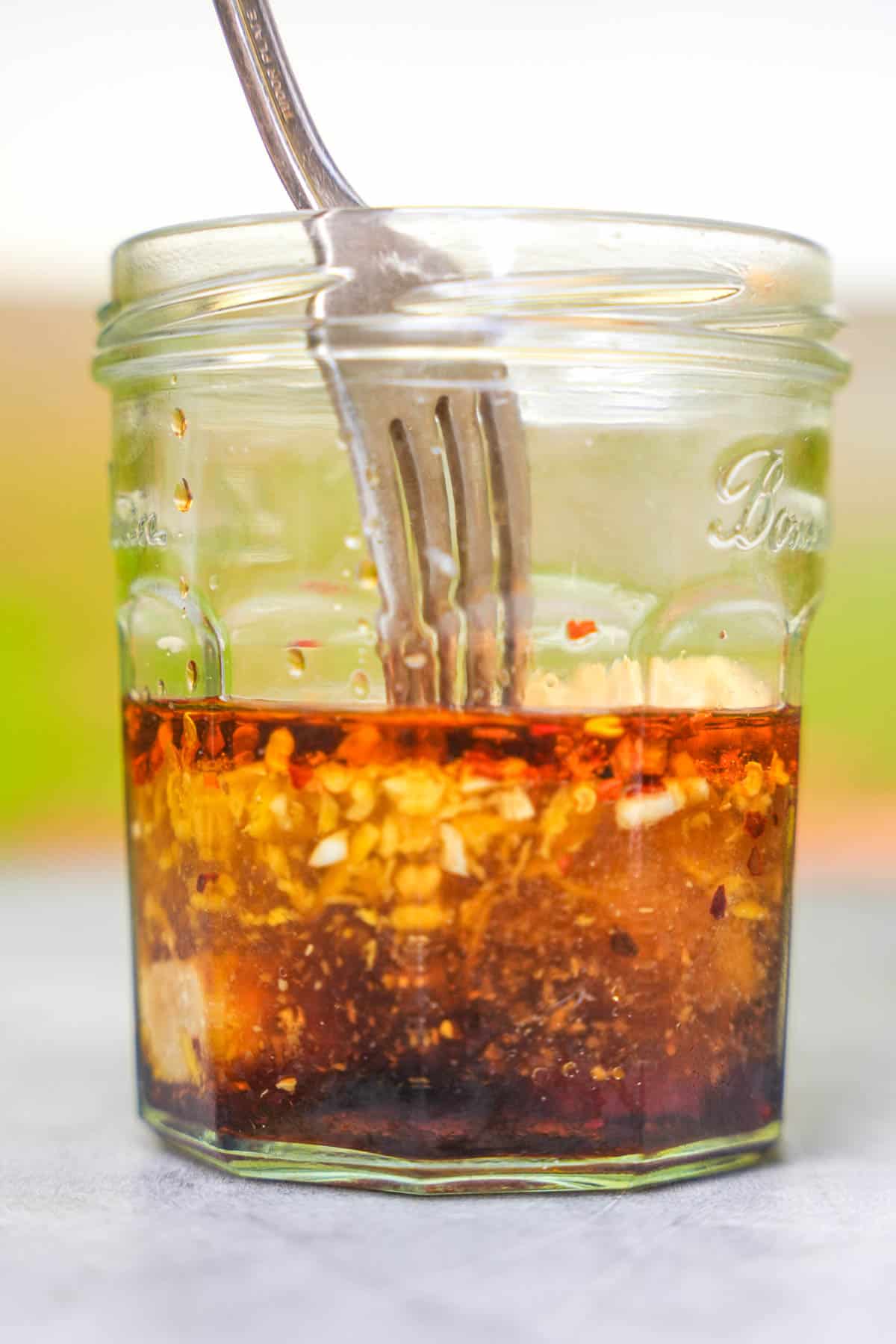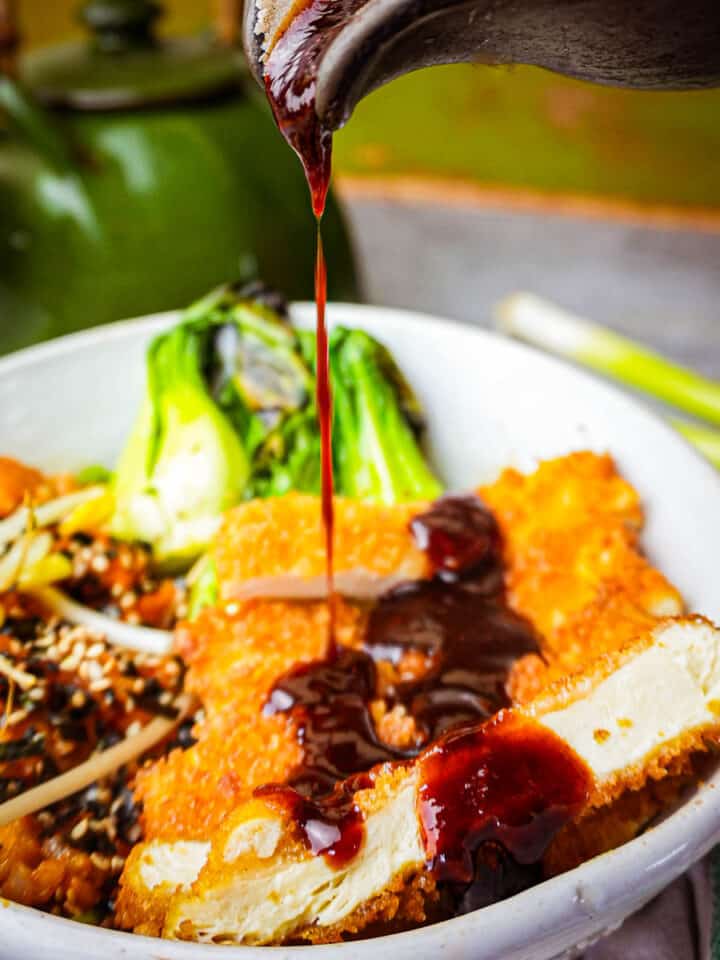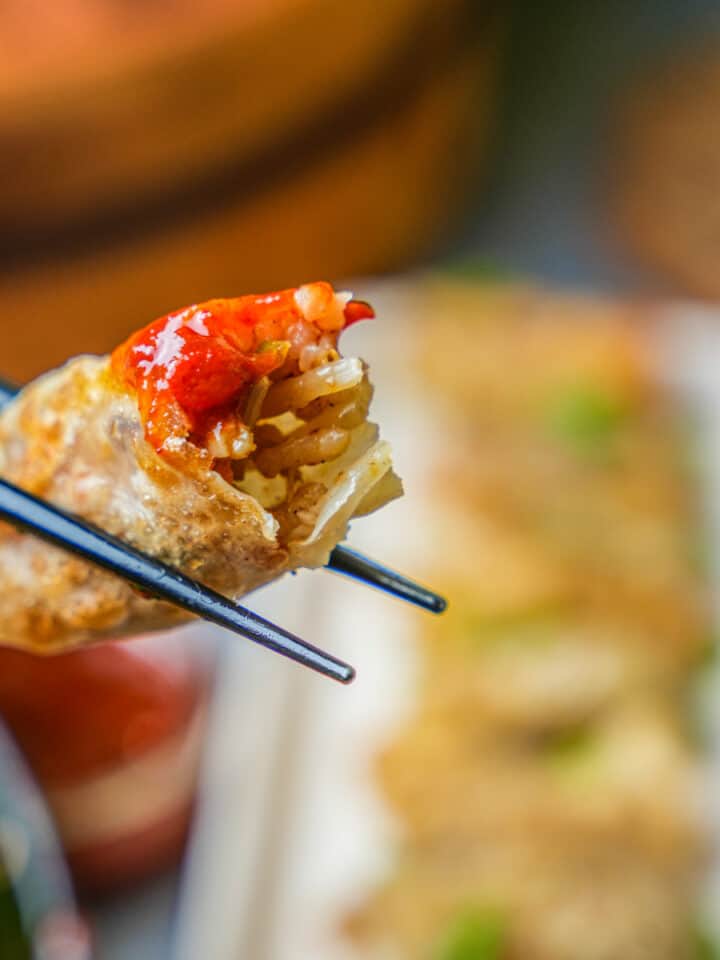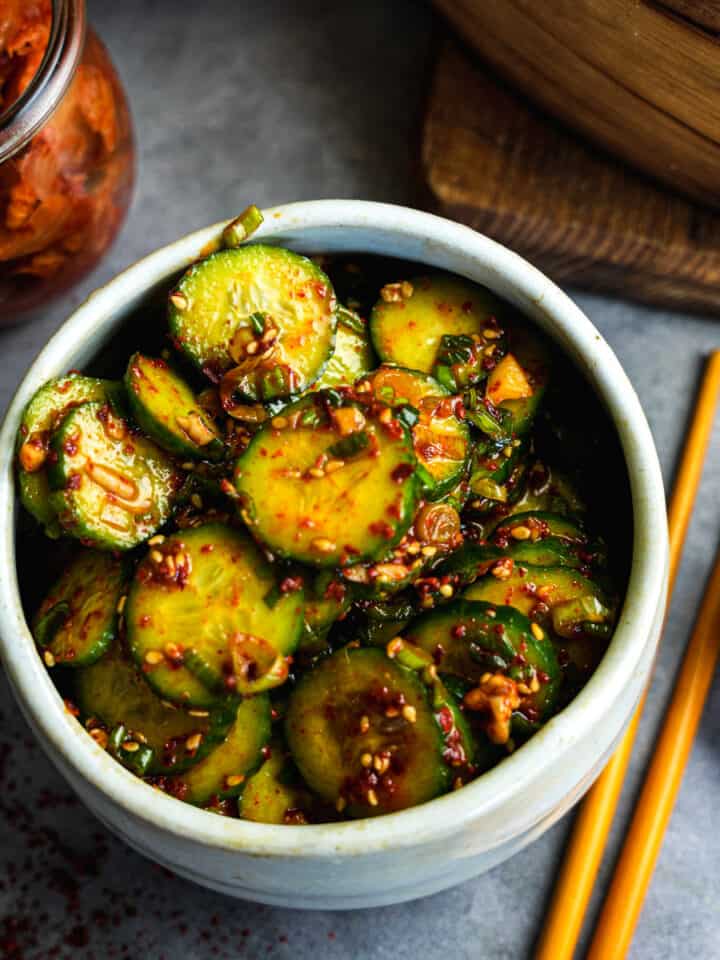*This post may contain affiliate links. Read more »
Looking for a severely yummy, stupidly easy miso glazed eggplant? Nasu Dengaku is a creamy, dreamy slice of roasted eggplant from your best Japanese dreams. "Nasu" means aubergine or eggplant, while "Dengaku" refers to skewered food often coated with a sweet and savory miso glaze.


Enter your email & I'll send it to your inbox. Plus, get great new recipes from me every week!
By submitting this form, you consent to receive emails from Cinnamon Snail.
Miso glazed eggplant actually holds a pretty special place in Japanese culinary culture, tracing its origins back to the Edo period. During this time, dengaku was served as a snack during temple festivals, captivating locals with its irresistible combination of smoky, charred aubergine and a luscious, umami-rich miso glaze. It makes an impressive, easy-to-make vegan, gluten-free dinner with a balance of flavors, textures and elegant presentation.
Cooking Nasu Dengaku is not just about preparing a boring ol’ aubergine; it's about embracing a cultural tradition and celebrating the artistry of Japanese cuisine. It goes great with my tofu katsu, a side of yamagobo (crisp Japanese pickled burdock), or a salad drizzled with classic sesame goma dressing.
Unleash your creativity, explore new tastes, and experience the magic of Japanese cuisine. Let's dive in and cook together!
Jump to:

🥰Why you'll adore this nasu dengaku recipe
✊Vegan AF: Like all of my vegan Japanese recipes, no cute critters have to be harmed in making this (or any dinner). Every meal you make that doesn’t include animal-based ingredients is a matter of life and respect for animals. Go vegan already!
🙅♀️🌾Gluten-Free: Since you hate gluten’s guts, you will be super-glad to know that this recipe hates gluten too. No problems with you having to see or even think about wheat in any of my gluten-free vegan recipes!
✅Tested and Approved Worldwide: Like all of the vegan recipes I publish, this Nasu Dengaku recipe has undergone extensive testing to ensure you will knock it out of the park. Not only have I personally fine-tuned this recipe, but it's been put through the paces by hundreds of recipe testers who work with me from all around the world!


👩🍳 Learn to make the BEST vegan Japanese food
This 5-day guide to my most popular Japanese recipes is 100% FREE, & you'll love the actual heck out of it 🥰
🍆 Ingredients for miso glazed eggplant

Aubergine (Eggplant)
Aubergine, known as "nasu" in Japan, is a versatile vegetable with a rich, meaty texture. It is a low-calorie ingredient packed with dietary fiber, antioxidants, and vitamins. If small eggplants are not available, you can substitute them with medium-sized ones, adjusting the cooking time accordingly. You can make this recipe with graffiti eggplants, small black-skinned eggplants, Korean or Japanese eggplants, but don't use the tiny Thai eggplant, like you would use for making sayur lodeh. Save big black eggplant for making Şakşuka or soslu patlican with!
Miso Paste
The white miso in this recipe, is a fermented soybean paste that originates from Japan. It adds depth, umami, and a touch of sweetness to the dish. Besides its incredible flavor, miso paste is a good source of protein, vitamins, and minerals. If white miso paste is not available, you can substitute it with taucu, Chinese fermented bean paste or red miso for a similar flavor profile. Some of these other fermented pastes are a bit saltier, so you may want to cut back on the tamari if you use them.
Maple Syrup
Maple syrup ain't just to pour all over your vegan pancakes! Here it adds a hint of caramel-like flavor and balances the acidity of the rice vinegar in this recipe. If you don't have maple syrup, you can substitute it with agave nectar or date syrup.
Toasted Sesame Oil
Toasted sesame oil imparts a distinctive nutty aroma and flavor to the eggplant. If you don't have toasted sesame oil, regular sesame oil, or even other cooking oils such as olive oil or canola oil can be used as a substitute.
*See the recipe card at the bottom of the page for exact quantities, nutritional info, and detailed cooking directions.
📖 Making perfect miso glazed eggplant
Hold onto my hand. Together, dressed as eggplants with arms and legs in giant foam costumes, we will conquer the miso-glazed galaxy together! …or you can follow along with the easy-to-print recipe card towards the bottom of this page.

Step 1
Cut the eggplants in half lengthwise. Use a sharp knife to make diagonal cuts or a criss-cross pattern on the inside of the eggplant. The cuts should create 1 cm. squares or diamonds. Be mindful of the depth of the cuts, ensuring they are deep, while keeping the skin intact to prevent the eggplant from falling apart during cooking.

Step 2
Take one tablespoon of toasted sesame oil and brush it evenly on the flesh side of the eggplants.
Heat a large oven-safe skillet or pan over medium-high heat. Once the pan is hot, carefully place the eggplants flesh side down in the pan. Allow them to cook for 3-4 minutes until a lovely golden-brown sear develops. This initial searing will provide a delicious texture and enhance the overall flavor.
✅If you do not have an oven-safe skillet, you can transfer the stovetop-cooked eggplant to a parchment paper-lined baking sheet when it is time to roast.

Step 3
While the eggplants are cooking, using the tines of a fork or small whisk, combine the white miso paste, sesame oil, minced garlic, crushed red pepper flakes, grated ginger, tamari, rice vinegar, maple syrup, and water in a small bowl.

Step 4
Flip the eggplants over, so the flesh side is facing up. Spoon the miso glaze mixture evenly over the flesh side of the eggplants. Make sure to coat each piece generously, allowing the glaze to seep into the cuts.

Step 5
If your skillet or pan is oven safe, you can transfer it directly to the preheated oven. Bake the eggplants at 400°F (200°C) for approximately 15-20 minutes until they become tender, and the miso glaze caramelizes and starts bubbling. The aroma will be simply irresistible!
✅If you do not have an oven-safe skillet, you can transfer the stovetop-cooked eggplant to a parchment paper-lined baking sheet when it is time to roast.

Step 6
Once the eggplants are roasted, remove them from the oven and let them cool slightly.
Garnish the eggplants with toasted sesame seeds, furikake, or shichimi togarashi, and thinly sliced scallions.
🍽️Serving Ideas
When it comes to serving Nasu Dengaku, the possibilities are endless, as its versatile flavors can be complemented by a variety of satisfying vegetarian recipes.
A vegan Korean protein to serve with this is seitan bulgogi. The smoky, savory bulgogi made with homemade seitan perfectly complements the sweet miso glaze. Add a bowl of Indonesian pilau or kimchi fried rice, made with easy homemade kimchi for a burst of tangy and spicy flavors.
You can also serve it over Indonesian pandan-scented coconut rice, or over Turkish bulgur pilavi or tabbouleh. All of these are great options as they can easily be made in advance, and are also convenient for meal prep.

✅ Top tips
- Choose the Right Eggplants: Opt for small to medium-sized eggplants that are firm and shiny. These tend to have fewer seeds and a more tender texture, which works well for this recipe.
- Even Cuts: When scoring the eggplant, aim for uniform cuts to ensure even cooking and flavor absorption. Diagonal cuts or a criss-cross pattern about 1 cm deep are perfect.
- Miso Glaze Consistency: Achieve the right balance between thick and pourable miso glaze. Adjust the amount of water if needed to get the desired consistency for easy spooning and spreading.
- Mindful Baking Time: Keep an eye on the eggplants while baking. Aim for tender, caramelized results, but avoid overcooking, which could result in mushiness.
🤷♀️FAQ
Traditionally, Miso Aubergines are not specifically vegan, as their preparation can vary depending on the specific recipe. The classic preparation of Nasu Dengaku typically includes miso glaze, which traditionally contains fermented soybeans, a staple ingredient in Japanese cuisine. However, some variations of the miso glaze may include non-vegan additives such as fish-based dashi broth or bonito flakes.
To ensure it is completely free of animal products, it is best to prepare it yourself so you know 100% what is in it.
This depends on the type of soy sauce used. If you avoid gluten, Tamari, coconut aminos, and wheat-free soy sauce are safe bets. Otherwise, many commercial soy sauces including Nama shoyu are produced using wheat.
✌️See ya later, ‘frigerator
Once cooled to room temperature, transfer any leftover Nasu Dengaku to an airtight container.
Place the container in the refrigerator and store it for up to 3 days. The flavors will continue to meld and develop over time.
🔥Stovetop Reheating
To reheat on the stovetop, place a non-stick skillet or pan over medium heat. Add the chilled Nasu Dengaku to the skillet and cook for 5-7 minutes, stirring occasionally, until heated through. Garnish with fresh scallions and sesame seeds after reheating.
☢️Microwave Reheating
Transfer the leftover Nasu Dengaku to a microwave-safe dish.
Cover the dish with a microwave-safe lid or microwave-safe plate to retain moisture.
Microwave on medium heat in 1-minute intervals, flipping the eggplant between each interval, until thoroughly heated. Garnish with fresh scallions and sesame seeds after reheating.
Nasu Dengaku does not freeze well due to the texture changes that occur when the dish is thawed. It is best enjoyed fresh or within a few days of preparation. In other words, you CAN freeze it, but it will be awful…
✌️My faves to serve with this miso glazed eggplant recipe

Nasu Dengaku (Japanese Miso Glazed Eggplant)
Ingredients
- 3 small eggplants
- 1 tablespoon toasted sesame oil
- 3 tablespoons miso paste
- 4 teaspoons sesame oil
- 1 clove garlic minced
- ½ teaspoon crushed red pepper flakes
- ½ teaspoon grated ginger
- 1 tablespoon tamari
- 1 tablespoon rice vinegar
- 3 tablespoons maple syrup
- 2 tablespoons water
Garnish:
- 2 teaspoons toasted sesame seeds
- 1 scallion thinly sliced
Instructions
- Preheat your oven to 400°F (200°C).
- Cut the eggplants in half lengthwise. Use a sharp knife to make diagonal cuts or a criss-cross pattern, scoring the inside of the aubergine. This should create a pattern of 1 cm. Squares or diamonds. Ensure the cuts are deep, while leaving the skin intact so the eggplant doesn’t fall apart.
- Brush the flesh side of the eggplants with one tablespoon of toasted sesame oil.
- Heat a large oven-safe skillet or pan over medium-high heat. Place the eggplants flesh side down in the pan and cook for 3-4 minutes until they develop a golden-brown sear.
- While the eggplant is cooking, in a small bowl, combine the white miso paste, sesame oil, minced garlic, crushed red pepper flakes, grated ginger, tamari, rice vinegar, maple syrup, and water. Mix well until the ingredients are thoroughly combined.
- Flip the eggplants over and spoon the miso mixture evenly over the flesh side.
- If your skillet or pan is oven safe, transfer it to the preheated oven and bake for 15-20 minutes until the eggplants are tender and the miso glaze is caramelized and bubbling. If your pan is not oven safe, carefully transfer the eggplant to a parchment paper-lined baking pan before roasting.
- Remove the eggplants from the oven and let them cool slightly.
- Garnish the miso-glazed aubergines with toasted sesame seeds and thinly sliced spring onions before serving.
Notes
- Choose the Right Eggplants: Opt for small to medium-sized eggplants that are firm and shiny. These tend to have fewer seeds and a more tender texture, which works well for this recipe.
- Even Cuts: When scoring the eggplant, aim for uniform cuts to ensure even cooking and flavor absorption. Diagonal cuts or a criss-cross pattern about 1 cm deep are perfect.
- Mindful Baking Time: Keep an eye on the eggplants while baking. Aim for tender, caramelized results, but avoid overcooking, which could result in mushiness, or burnt glaze.

Enter your email & I'll send it to your inbox. Plus, get great new recipes from me every week!
By submitting this form, you consent to receive emails from Cinnamon Snail.









Meg says
Oh my. This takes eggplant to a whole different level. When I think of yum food, ummm eggplant doesn’t get a mention….bug now maybe it might. Suddenly it tastes like something amazing. Thank you Chef Adam. Another winner. And did I mention quick n easy? Yup.
Karen Richter says
Oops! Forgot to add that I made Oi Muchim (Korean Cucumber Salad) to go with the Nasu Dengaku! Such an easy dish to prepare as the miso glaze on the eggplant caramelized and bubbled away in the oven. As the oven bell went off, I'd finished putting the cucumber salad together and added all the garnishes while the eggplant was cooling for just a bit. I've got pictures of the finished products. Absolute yummers!
Karen Richter says
Just made this tonight in-between prep for our family gathering on Thanksgiving Friday. It was so easy and I had all ingredients on hand, however, this was an impromptu/last minute "quickie" of a dinner for me and the 1 small eggplant that needed to be eaten, and I admit, I went and did it, and used granulated garlic and powdered ginger. It was still so yummy and when I make it again - 'cause I will - I will use all the ingredients as listed with pleasure in anticipation for a great dish!
Laura Severance says
My husband hates eggplant, so I made this for dinner. 🙂 He actually liked it a lot! The sauce is just incredible. I think I overcooked mine; it was a bit mushy, so next time I will watch it more closely. This recipe is a real keeper.......I am thinking of making it into a sandwich next time.
Adam Sobel says
Haha. Glad you liked it a lot. "My husband hates eggplant so I made him eggplant". I am so psyched he's a convert. You ( and maybe even your huzzy) might like the Thai Basil Eggplant next!
Laura Severance says
We love Thai food, so I'll definitely put that in the rotation. Thanks!
amy says
Made it tonight - really good! A definite keeper!
Stephanie C. says
Awesome tasting recipe, don't hesitate to try. I made it keto by replacing the maple syrup with stevia (adjust to taste). Turned out phenomenal and will be a permanent dish in our meal rotation. Thanks, Adam!
Adam Sobel says
So glad you loved it. Great idea with the stevia as an easy keto hack.
KRB says
This is one of my favorite dishes at Japanese restaurants but I've never been able to get decent results at home. I got some beautiful eggplant at the farmers market last week and decided to give this a shot. Delicious! Came together so easily, with ingredients I usually have on hand. I can't stand turning my oven on in this hot, humid weather so I halved the recipe and it fit in my (albeit large) toaster oven. Will definitely make this again!
Adam Sobel says
Cutting the eggplant to let the marinade in speeds up the cooking and gets the internal flesh nice and creamy. I am so glad you loved it!
Heather says
Thank you Adam this was a five star recipe, so easy to assemble and it turned out great. I didn't know eggplant could be so tasty until I made the miso glazed eggplant. This is an easy summer lunch with salad, that can also be prepared ahead of time. Would give this 10 stars for taste!
Adam Sobel says
I'm so glad you loved it Heather. There are a handful of very tasty eggplant recipes here on the blog. You should DEF make the Sayur Lodeh and Turkish Saksuka if you haven't yet. Both will make you love eggplant even more1
Kate D. says
DELICIOUS! Easy to put together using ingredients you likely have in your pantry. I had a “regular “eggplant begging to be used, I left the skin on, sliced it in inch thick round slices and scored as the recipe indicated. Turned out great. I’m sure if you enjoy grilling this recipe could easily adapt using a grill pan.
David says
Made this tonight. So good! And totally doable on a weeknight.
I think miso is my new best friend.
Thanks for the recipe! (and I know it's been a while, but I miss your truck in Hoboken)
Adam Sobel says
I miss having my truck in Hoboken! Come visit my new top-secret pop-up thing one of these Sundays in Red Bank. 😘